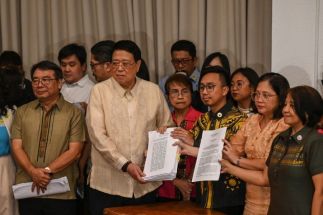The continuing Bt corn war
July 15, 2004 | 12:00am
In 2001, President Arroyo issued a National Biotechnology Policy – "(The Philippines) shall promote the safe and responsible use of modern biotechnology and its products as one of several means to achieve and sustain food security, equitable access to health services, sustainable and safe environment, and industry development." In April 2002, the Department of Agriculture released Administrative Order No. 8, which provided rules and regulations for the importation and release into the environment of plants and plant products derived from the use of modern biotechnology. In December 2002, the Bureau of Plant Industry approved the commercial propagation of Bt corn MON810.
In 2002, about 120 hectares of Bt corn were planted. Because of the significantly increased yields obtained, by mid-2004, 12,000 hectares had been planted on various islands. In the planting season ending in May 2004, one farmer obtained 10.2 tons of shelled corn per hectare in his 10-hectare plot. Apprised of this yield, corn planters in his village have planted over 300 hectares of corn. One advantage this farmer mentioned is the capability to plant corn three times a year. Previously, no more than two crops could be planted per year because moisture patterns saw massive infestations of the third crop by borers.
The Philippines annually imports about one million metric tons of corn or corn substitutes. With the potential of Bt corn to significantly increase yields, for the first time in many years, there is the strong likelihood that the Philippines will not only stop importing corn, it could divert more of this corn to increasing value-added produce in the form of increased production of chicken, pork and other agricultural outputs.
This potential to improve food security and to directly address malnutrition that still exists in the country can be adversely affected by FUD (Fear, Uncertainty and Doubt) tactics. Media printed the pronouncements of Norwegian scientist Terje Traavik on Feb. 22, 2004 at the first Meeting of the Parties to the Convention on Biological Diversity in Kuala Lumpur, Malaysia. Traavik was reported to have said that 38 people in Kalyong, a village in Mindanao, carried increased levels of three different target antibodies, which he considered as evidence of an immune reaction to the Bt toxin built into the Bt corn to combat pests. Traavik was also reported to have said that "there’s no literature or scientific studies that could prove GMO safeness to human health and environment." During an early March visit to Mindanao, media reports said that when pressed as to whether the traces of Bt toxin in the blood samples were the result of the natives’ exposure to Bt corn, Traavik was quoted as saying, "It’s difficult to completely conclude if the Bt toxin, indeed, came from the Bt corn. We need to conduct further researches on that. However, this alarming finding should serve as early warning that it could be harmful to our health."
Within days of the pronouncements, Agriculture Secretary Luis Lorenzo Jr. called for an investigation. Dr. Artemio Salazar, director of the Department of Agriculture’s corn program, was reported to have explained that the claims of Traavik are not in consonance with the tenets of modern science. Nina Gloriani Barzaga, M.D., Ph.D., professor of medical microbiology and microbial immunology at the University of the Philippines’ College of Public Health, was quoted as saying that Traavik should show pertinent scientific data supporting his claims before publicly releasing them and causing undue panic.
On March 23, 2004, a widely circulated Philippine newspaper reported that 14 scientists and professors, mainly from the United States, challenged Traavik to publish on the Internet the full details of his study so it could be completely discussed by other experts in the field.
Government healthcare professionals in the area where the alleged ill-effects of exposure to Bt corn occurred expressed the opinion that the reported illnesses are unlikely due to the Bt corn. A private sector team involving physicians, which subsequently visited the place, confirmed the conclusions of the government health are professionals. Thus far (mid-May 2004), Traavik has failed to provide the raw data supporting his findings.
From the large number of reports from many newspapers regarding the pros and cons of GMOs, and the results of an independent survey showing popular print media as one of the major sources of information regarding these crops, it is clear that media plays a huge role in bringing down unwarranted barriers to international trade and in promoting science-based understanding and implementation of agricultural biotechnology.
Although media can be attracted by FUD newsmakers, it can also be utilized by responsible government officials and scientists to address relevant issues as quickly as possible to dispel doubts. Knowledge dissemination through daily broadsheets can augment the ongoing information campaign by entities such as the Biotechnology Information Center, the Biotechnology Coalition of the Philippines Inc., the Philippine National Academy of Science and Technology, the Department of Agriculture’s Biotechnology Program Implementation Unit and other groups.
Another potential problem for the adoption of GMOs is too stringent government regulations. To comply with the requirements of the Cartagena Protocol on Biosafety, the Department of Environment and Natural Resources (DENR) is crafting a National Biosafety Framework. In a March 2004 national workshop on the development of the Philippine Biosafety Framework, DENR Secretary Elisea Gozun pushed for the ratification by the Senate of the Cartagena Protocol, saying that the Protocol "creates an enabling environment for the environmentally sound application of biotechnology, making it possible to derive maximum benefits from the potential that biotechnology has to offer, while minimizing the possible risks to the environment and to human health." While acknowledging the positive impact of modern biotechnology on food security, she noted its potential impact on human health and the environment. "The use of biotechnology and its products must therefore be practiced in a safe and sustainable manner that minimizes the possibility of these adverse effects," Gozun said. She added, "We must follow precautions and take into account socio-economic and cultural considerations in making biosafety decisions."
Some sectors want the Philippine National Biosafety Framework to address the biosafety issue apart from socio-economic and cultural issues. It is clear that some countries have released GMOs into the environment many years (at least six years) before the Philippines did. Lessons learned by these early adopters could help later adopters like the Philippines and even later potential adopters, by shedding additional light through information-sharing. Regional as well as international cooperation would help pave the way for rational measures to reasonably meet the stakeholders’ needs.
While GMOs may provide advantages for producers and the public, FUD tactics and too stringent government regulations can slow down their adoption.
Benigno D. Peczon, Ph.D. in Chemistry, is a Balik-Scientist who has performed both basic and applied research. He currently serves as president of the Biotechnology Coalition of the Philippines Inc. For queries or comments on this article, e-mail at [email protected].
In 2002, about 120 hectares of Bt corn were planted. Because of the significantly increased yields obtained, by mid-2004, 12,000 hectares had been planted on various islands. In the planting season ending in May 2004, one farmer obtained 10.2 tons of shelled corn per hectare in his 10-hectare plot. Apprised of this yield, corn planters in his village have planted over 300 hectares of corn. One advantage this farmer mentioned is the capability to plant corn three times a year. Previously, no more than two crops could be planted per year because moisture patterns saw massive infestations of the third crop by borers.
The Philippines annually imports about one million metric tons of corn or corn substitutes. With the potential of Bt corn to significantly increase yields, for the first time in many years, there is the strong likelihood that the Philippines will not only stop importing corn, it could divert more of this corn to increasing value-added produce in the form of increased production of chicken, pork and other agricultural outputs.
This potential to improve food security and to directly address malnutrition that still exists in the country can be adversely affected by FUD (Fear, Uncertainty and Doubt) tactics. Media printed the pronouncements of Norwegian scientist Terje Traavik on Feb. 22, 2004 at the first Meeting of the Parties to the Convention on Biological Diversity in Kuala Lumpur, Malaysia. Traavik was reported to have said that 38 people in Kalyong, a village in Mindanao, carried increased levels of three different target antibodies, which he considered as evidence of an immune reaction to the Bt toxin built into the Bt corn to combat pests. Traavik was also reported to have said that "there’s no literature or scientific studies that could prove GMO safeness to human health and environment." During an early March visit to Mindanao, media reports said that when pressed as to whether the traces of Bt toxin in the blood samples were the result of the natives’ exposure to Bt corn, Traavik was quoted as saying, "It’s difficult to completely conclude if the Bt toxin, indeed, came from the Bt corn. We need to conduct further researches on that. However, this alarming finding should serve as early warning that it could be harmful to our health."
Within days of the pronouncements, Agriculture Secretary Luis Lorenzo Jr. called for an investigation. Dr. Artemio Salazar, director of the Department of Agriculture’s corn program, was reported to have explained that the claims of Traavik are not in consonance with the tenets of modern science. Nina Gloriani Barzaga, M.D., Ph.D., professor of medical microbiology and microbial immunology at the University of the Philippines’ College of Public Health, was quoted as saying that Traavik should show pertinent scientific data supporting his claims before publicly releasing them and causing undue panic.
On March 23, 2004, a widely circulated Philippine newspaper reported that 14 scientists and professors, mainly from the United States, challenged Traavik to publish on the Internet the full details of his study so it could be completely discussed by other experts in the field.
Government healthcare professionals in the area where the alleged ill-effects of exposure to Bt corn occurred expressed the opinion that the reported illnesses are unlikely due to the Bt corn. A private sector team involving physicians, which subsequently visited the place, confirmed the conclusions of the government health are professionals. Thus far (mid-May 2004), Traavik has failed to provide the raw data supporting his findings.
From the large number of reports from many newspapers regarding the pros and cons of GMOs, and the results of an independent survey showing popular print media as one of the major sources of information regarding these crops, it is clear that media plays a huge role in bringing down unwarranted barriers to international trade and in promoting science-based understanding and implementation of agricultural biotechnology.
Although media can be attracted by FUD newsmakers, it can also be utilized by responsible government officials and scientists to address relevant issues as quickly as possible to dispel doubts. Knowledge dissemination through daily broadsheets can augment the ongoing information campaign by entities such as the Biotechnology Information Center, the Biotechnology Coalition of the Philippines Inc., the Philippine National Academy of Science and Technology, the Department of Agriculture’s Biotechnology Program Implementation Unit and other groups.
Another potential problem for the adoption of GMOs is too stringent government regulations. To comply with the requirements of the Cartagena Protocol on Biosafety, the Department of Environment and Natural Resources (DENR) is crafting a National Biosafety Framework. In a March 2004 national workshop on the development of the Philippine Biosafety Framework, DENR Secretary Elisea Gozun pushed for the ratification by the Senate of the Cartagena Protocol, saying that the Protocol "creates an enabling environment for the environmentally sound application of biotechnology, making it possible to derive maximum benefits from the potential that biotechnology has to offer, while minimizing the possible risks to the environment and to human health." While acknowledging the positive impact of modern biotechnology on food security, she noted its potential impact on human health and the environment. "The use of biotechnology and its products must therefore be practiced in a safe and sustainable manner that minimizes the possibility of these adverse effects," Gozun said. She added, "We must follow precautions and take into account socio-economic and cultural considerations in making biosafety decisions."
Some sectors want the Philippine National Biosafety Framework to address the biosafety issue apart from socio-economic and cultural issues. It is clear that some countries have released GMOs into the environment many years (at least six years) before the Philippines did. Lessons learned by these early adopters could help later adopters like the Philippines and even later potential adopters, by shedding additional light through information-sharing. Regional as well as international cooperation would help pave the way for rational measures to reasonably meet the stakeholders’ needs.
While GMOs may provide advantages for producers and the public, FUD tactics and too stringent government regulations can slow down their adoption.
BrandSpace Articles
<
>
- Latest
Latest
Latest
October 11, 2024 - 12:49pm
October 11, 2024 - 12:49pm
September 30, 2024 - 8:00am
September 30, 2024 - 8:00am
September 26, 2024 - 2:00pm
September 26, 2024 - 2:00pm
September 3, 2024 - 1:00pm
September 3, 2024 - 1:00pm
Recommended






























